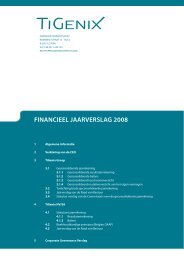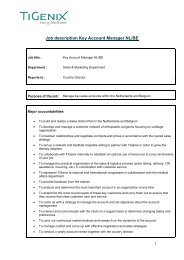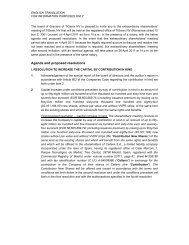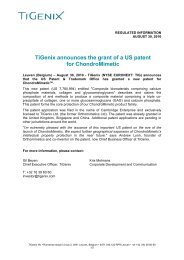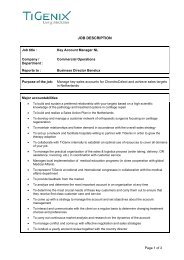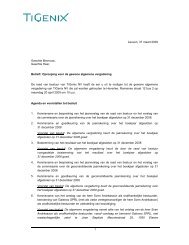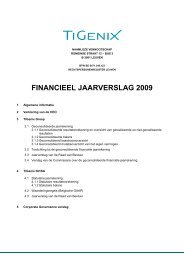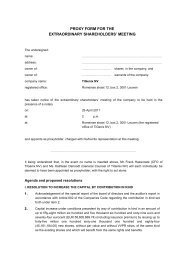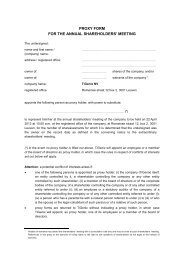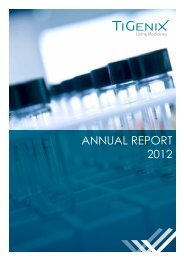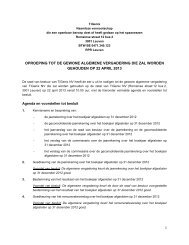ANNUAL FINANCIAL REPORT 2010 2010 - TiGenix
ANNUAL FINANCIAL REPORT 2010 2010 - TiGenix
ANNUAL FINANCIAL REPORT 2010 2010 - TiGenix
- No tags were found...
You also want an ePaper? Increase the reach of your titles
YUMPU automatically turns print PDFs into web optimized ePapers that Google loves.
6.14.3 History and development of CellerixCellerix began operations in the research and developmentof cell therapy product candidates in 2002 as a division ofGenetrix, S.L., a Spanish biotechnology incubator.Cellerix was spun-off from Genetrix in 2004 as a standalone entity. An overview of some of the key events andmilestones in Cellerix’ history is presented in the table below inchronological order:YearKey milestones & achievements2004 Incorporation of Cellerix SL as stand-alone businessObtained good manufacturing practice (“GMP”) certification as a pharmaceutical manufacturing facilityCx401 (former autologous product) initiates phase II trials in complex perianal fistulas2005 Closing of series A financing roundCx401 granted Orphan Drug status by the EMA2006 Cx501 granted Orphan Drug status by the EMAAcute phase of Cx401 phase II trial completed: 71% efficacy after 8 weeks2007 Series B closed with blue chip venture capital investors and corporate funds of large pharma companiesLicence and development agreement for Cx401 signed with Axcan Pharma2008 €10 million venture debt secured with ETV CapitalFirst patient successfully treated with Cx601 on compassionate use grounds2009 Cx601 is granted Orphan Drug status by EMASeries C financing round closed<strong>2010</strong> Results for first Phase III clinical trial of Cx401 in non-Crohn patientsGMP facility approved for commercial production of ATMPsCx601 receives positive results from Phase II clinical trialsResults of Cx501 Phase II clinical trial2011 Cx611 initiates Phase I/II clinical trialsAnnounces business combination with <strong>TiGenix</strong> NVCx601 received positive EMA scientific advice for Phase III trial6.14.4 Market opportunityPerianal fistula in Crohn´s DiseaseCrohn’s disease is a chronic inflammatory disease of theintestine of unknown etiology. It is characterized by focalor segmental transmural inflammation which may occur inany part of the digestive tract with occasional granulomaformation. The transmural inflammation disrupts intestinalmucosal integrity, favouring the development of abscesses andfistulas. A fistula is an abnormal tract connecting two surfaces;a perianal fistula is defined as a tract between the perianalspace and the epithelial surface proximal to the anus. Althoughmultiple schemes of fistula classification have been proposed,none have been universally adopted. However, the AmericanGastroenterology Association recommends classificationaccording to complexity as either complex or simple. Patientswith complex fistula involving large portions of the sphinctermuscles are generally accepted as being at high risk ofincontinence subsequent to aggressive surgical interventionand of having low healing rates.Symptomatic perianal fistulas in patients with Crohn’sdisease can have a large negative impact on quality of lifeand treatment of complex perianal fistulas remains a difficultproblem.Limited data is available on the epidemiology of perianalfistula in Crohn´s disease patients. Cellerix has estimated theworldwide epidemiology of the indication on the basis ofcollated scientific publications (up to 2007) based on (i) knownCrohn´s disease epidemiology, (ii) the assumption thatapproximately 12% of Crohn’s disease patients will develop aperianal fistula and (iii) that 80% of these will be classified ascomplex.The following graphs provide an overview of the estimatedpatient population suffering from complex perianal fistula inEurope and USA:134 • <strong>TiGenix</strong> • Rights Offering



